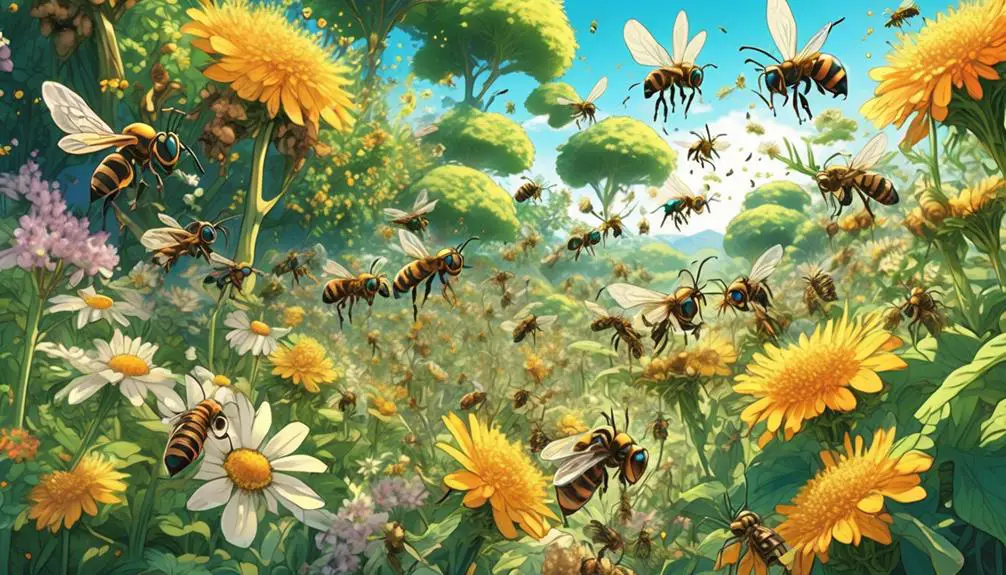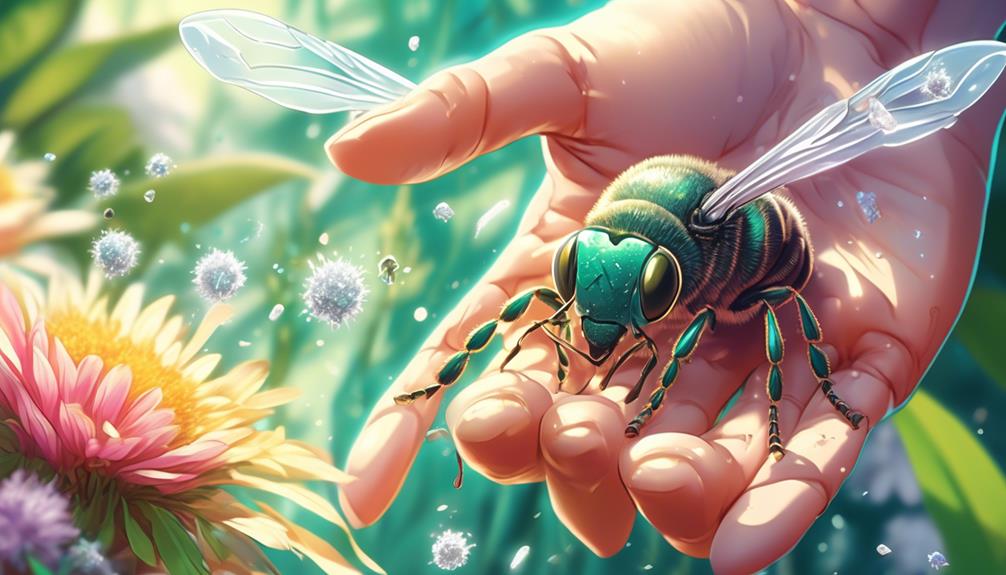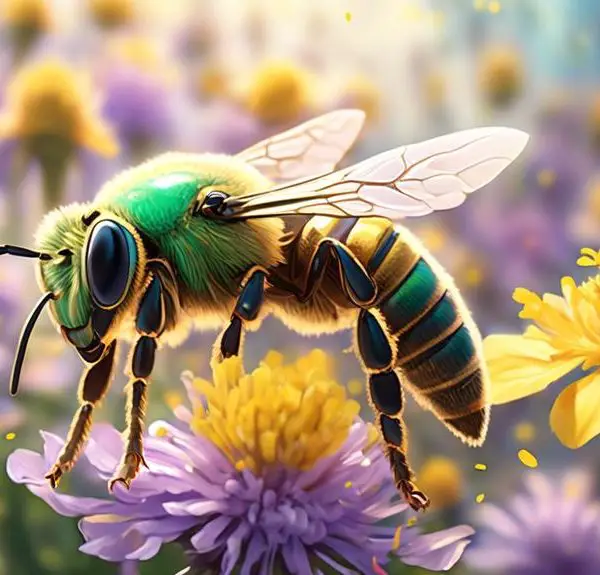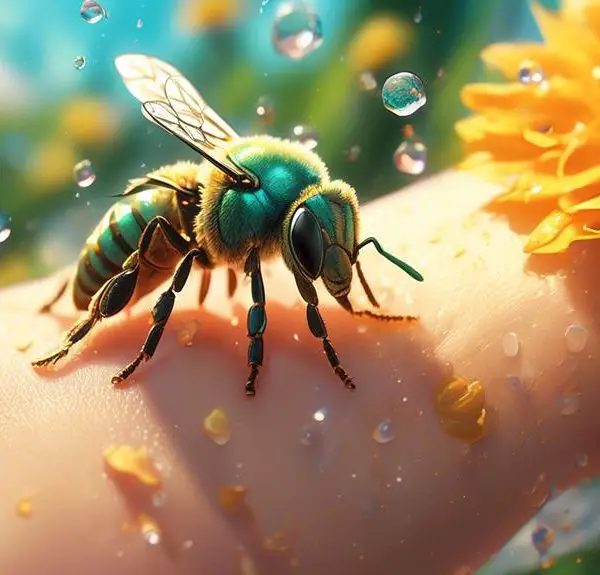Stumble upon the astonishing world of sweat bees and uncover the secret behind their staggering population in the United States.

Why Do We Have so Many Sweat Bees
You know how a single grain of sand seems insignificant until you're standing on a beach? That's kind of like the situation with sweat bees. Despite their tiny size, these insects are present in staggering numbers.
It's estimated that there are over 1000 species of sweat bees in the United States alone. But why is that? Well, these bees do play a key role in our ecosystem, but there's more to their abundance than initially meets the eye.
Stick around, and let's explore this intriguing phenomenon together.
Key Takeaways
- Sweat bees are important pollinators that contribute to biodiversity and ecosystem health.
- They are attracted to human sweat due to its high salt content and specific scent, but their attraction is not harmful.
- Factors such as habitat destruction, limited food sources, extreme weather, predators, and pesticide exposure can impact sweat bees' population.
- Managing sweat bees' presence can be achieved through strategies like limiting access to human sweat, changing the landscape, and creating designated areas in the garden.
Understanding Sweat Bees

While sweat bees may seem like an oddity, they're a fascinating part of the bee family, attracted to humans primarily for their perspiration, which provides essential minerals for their survival. Belonging to the Halictidae family, these bees are quite common, comprising nearly 20% of the known bee species worldwide.
Unlike their more infamous relatives, such as honeybees or bumblebees, sweat bees are solitary creatures. They don't live in large colonies but prefer to nest in the ground or wood, often in your garden. They're also considerably less aggressive, stinging only when threatened or accidentally squashed.
Sweat bees play a critical role in pollination. They're generalist foragers, collecting pollen from a wide range of plants. This adaptability makes them incredibly valuable in maintaining biodiversity and the health of ecosystems.
Their attraction to sweat, hence the name, is due to its high salt content. Sweat provides them with sodium, a vital mineral that's often scarce in their typical diet of nectar and pollen. So, next time you're out in the garden and notice a small, metallic bug on your skin, don't swat it away. It's just a sweat bee, going about its crucial work.
Sweat Bees Ecological Significance

Sweat bees' ecological importance can't be overstated, as they're instrumental in the pollination process, contributing significantly to the biodiversity and health of our ecosystems. They're not just pollen transporters, but also natural fertilizers, helping to propagate plant species. This ensures a diverse and flourishing flora, which in turn supports diverse fauna.
Their small size allows them to access flowers that larger bees can't, pollinating a broader range of plants. This has a ripple effect on the entire ecosystem, promoting the survival of various species – both flora and fauna. Furthermore, sweat bees' predation on other insects contributes to natural pest control, adding another layer to their ecological significance.
However, their contribution isn't limited to nature alone, they're vital for human survival too. They play a critical role in the pollination of crops, including fruits, vegetables, and nuts. With the decline in honeybee populations, their significance is more profound than ever.
Sweat Bees Attraction to Human Sweat

Despite their ecological significance, you might find yourself less appreciative of sweat bees when they're attracted to your perspiration, a bizarre yet fascinating phenomenon in the insect world. This attraction isn't a mere coincidence. In fact, it's a scientifically intriguing characteristic of these tiny pollinators.
The sweat secreted by your body contains minerals, particularly sodium, which is a significant nutritional requirement for sweat bees. Your perspiration is like a sodium buffet for these bees, who can't resist its allure. They're equipped with specialized, sodium-detecting antennae that help them locate the source of this vital nutrient.
Moreover, sweat bees have evolved to be attracted to the specific scent of human sweat. Your perspiration releases certain pheromones and organic compounds that these bees find irresistible. It's akin to us smelling freshly baked bread or a sizzling steak.
However, as annoying as their presence might be, it's crucial to remember that sweat bees are generally harmless. They're not out to harm you, they're simply on a quest for sodium. So next time you find a sweat bee hovering around you, understand that it's your sweat's composition and scent that's drawn them in.
Factors Influencing Sweat Bees Population

Moving from their attraction to human sweat, it's also essential to understand the various factors that play a significant role in influencing the population of sweat bees. They're not just attracted by your perspiration; their survival and growth depend on a variety of environmental and biological factors.
Factor | Explanation | Impact on Sweat Bees |
|---|---|---|
Habitat | Sweat bees thrive in areas with ample soil for nesting, like gardens or woodlands. | Destruction of these habitats can decrease the population. |
Food Source | They feed on nectar and pollen from flowers, and sometimes human sweat. | Limited food sources can hinder their growth. |
Climate | They prefer warm, temperate climates. | Extreme weather conditions can affect their survival. |
Predators | Birds, spiders, and other insects prey on sweat bees. | High predator presence can reduce their numbers. |
Pesticides | These bees are susceptible to chemicals used in farming. | Pesticide exposure can lead to population decline. |
Managing Sweat Bees Presence

In managing the presence of sweat bees, it's crucial to understand their behaviors and adapt your strategies accordingly. These bees, despite their seemingly intrusive nature, are beneficial pollinators and shouldn't be exterminated unnecessarily. However, if their population becomes too large or they become a nuisance, there are ways to manage them.
One method is to limit their access to human sweat, their primary attraction. You can accomplish this by wearing light-colored clothing, reducing your outdoor activities during peak bee activity hours, or using insect repellent. Remember, sweat bees are attracted to perspiration and the salts it contains.
Another approach is changing your landscape to make it less attractive to these bees. Reducing exposed soil and mulching can discourage ground-dwelling species from nesting. Planting less attractive plants for sweat bees can also help.
Lastly, consider creating a designated area in your garden for sweat bees. This can help direct activity away from high-traffic areas. Place salt licks or shallow water sources to attract the bees to this area.
Conclusion
So, you've learned a lot about sweat bees, their ecological importance, and their peculiar attraction to human sweat.
It's clear that various factors contribute to their population, and managing their presence is essential. Remember, these tiny creatures play a vital role in our ecosystem.
While they may be a nuisance at times, their existence is crucial. With understanding and proper management, we can coexist peacefully with these busy, sweat-loving bees.


